Hiking to Kanag Devi Temple, Theog (Shimla) and a Day Picnic in the Pastures
Maybe I should be ashamed about not knowing the deity of the Kanag Devi temple.
My host in the apple village of Fagu (in Shimla district) had told us the temple is located in heaven. But when she said the walk to Kanag temple is half an hour from the motorable Sarion village, I had my doubts. Most heavens don’t lie within half an hour of human settlements. Every gorgeous and untouched place is at least a few hours strenuous hike away here in Himachal. But then another tourist family from Delhi praised the Kanag temple as heaven which they didn’t want to leave. If only they had found some trees at the top under whose shade they could sprawl, they would have made their home there. The woman of the family said.
How could they not find trees in Himachal? I wondered but kept quiet.
Keeping our doubts aside, we planned to go there the next day. But at some demon hour at night, I woke up with the thunder roaring into my ears and the lightning brightening our room through the drawn curtains. I can’t say for how long I shuffled between sleep and wakefulness.
Sometime during these disturbed hours, the clouds had started pouring over the Shimla valley. The light was so blinding and the thunderstorm so loud I was sure I was standing under the sky. Turning off my usual 5 am alarm, I finally got out of bed at 6. Thick grey clouds seemed settled in the sky. Who knows where the sun was. The grounds were wet. The freshly washed valley and the villages ahead shone brightly. And anyone could tell that it would rain anytime again.
“Can we go in such a weather?” I asked my host while gazing at the beautiful vista laid in front.
“Let’s see if it clears up.”
We showered and packed our bags with the usual Kindle, earphones, umbrella (love this one), bedsheet, water bottles, fruits, and power bank for our phones. The sky had started to open up but as I went out of the house to grab my shoes I realized they were drenched. Sometimes this keeping the stinky shoes out of the house idea doesn’t go so well for me. We found extra pairs from our car and drove on into the direction of Theog village ahead of which lay Sarion, the base point of the hike.
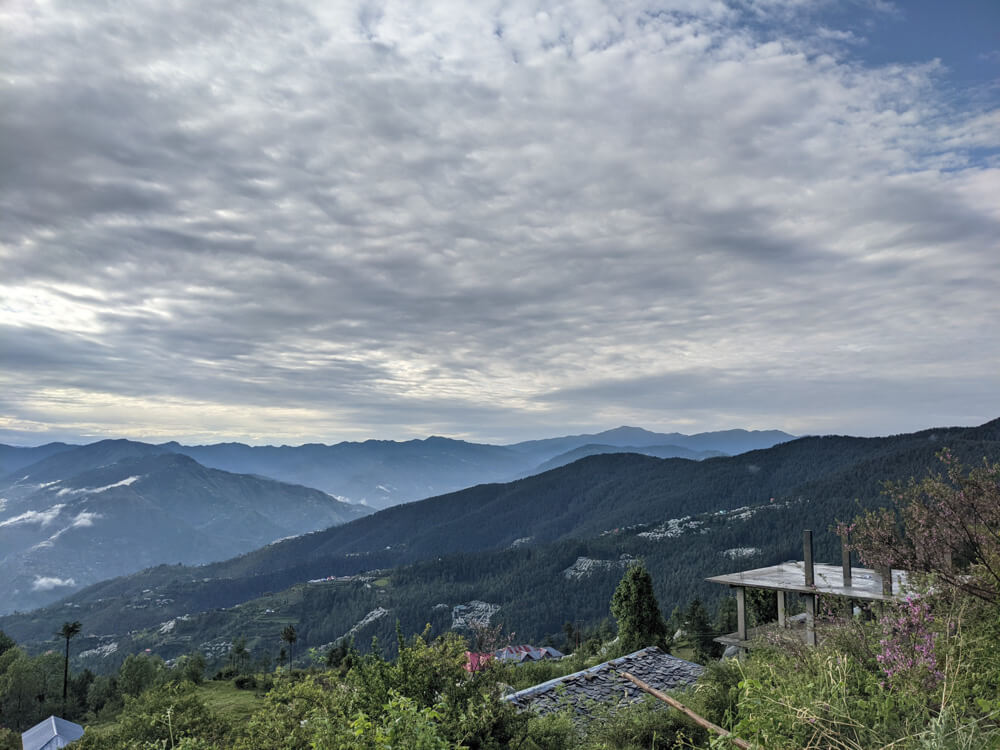
“Maybe some dhaba would be open now.” My hungry partner hoped. The clock had struck 8 am so food wasn’t going to be an issue.
Waving bye to our host aunty who was sad we hadn’t asked her to pack parathas, we drove on. (To be fair to us, we had taken her parathas a day earlier for Taani Jubbal lake and didn’t have the heart to eat raw parathas with cauliflower soaking in oil again. But to be fair to her she had made the food at short notice.)
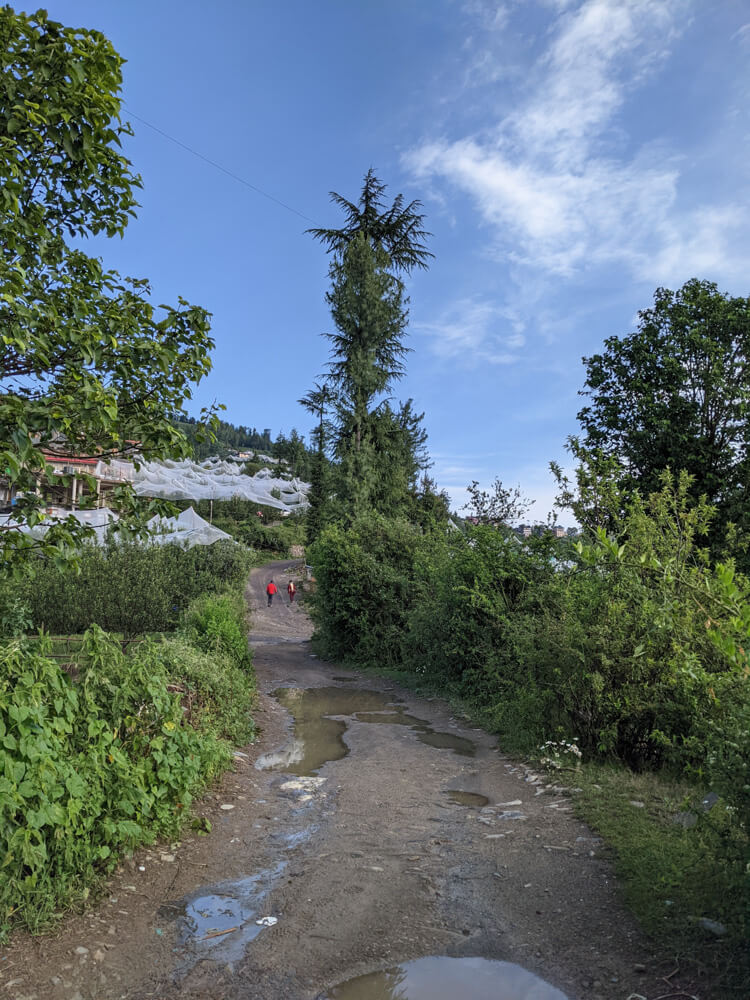
The uphill road in front of our guesthouse to the highway was a kaccha-pakka road broken at quite a few places. Now it had many puddles full of rainwater. Once on the main highway, we turned right towards Theog.
I had never heard of these Shimla villages before this trip to Himachal. My Himachal travel was limited to Dharamshala, Parvati Valley, Spiti Valley, and Manali apart from some past trips about which I don’t have anything recommendable to say. But in these couple of months I have seen so many of these mountain settlements I’m sure I would never be able to see them all. These villages which seem precariously perched on green hill slopes have been in their place for a long time. Every home tells the story of many generations. Their fields, cowsheds, orchards — which they lovingly call bageecha, hamams — a wooden water heater sitting right outside every home, chimneys, stone huts, all have been in their place for at least 200 years. But now a lot of families have started to move out of the old mud and stone dwellings and are even making cement homes.
While admiring these hilly villages, we approached a market whose shops displayed Theog on their signboards. It was almost 8:30 am and I wasn’t still hungry so we drove on assuming we will get more dhabas further on the way.
Our Google Maps was set to Sarion. When we drove further, we arrived at a point where the maps asked us to go up a kaccha road on our right. Homestay uncle had told us the road was kaccha but drivable. After 1.5 km of the kaccha path, we were supposed to park our car near some shops and climb from there.
We called our host, and he confirmed we were at the right spot. A dhaba located opposite the road also said that was the road we had to take to Kanag Devi.
But to date, we have avoided driving on kaccha roads here in Himachal. Also as it had rained the path looked more broken, and we were sure it would have water puddles in between. So we decided we would park the car near the dhaba and go on foot.
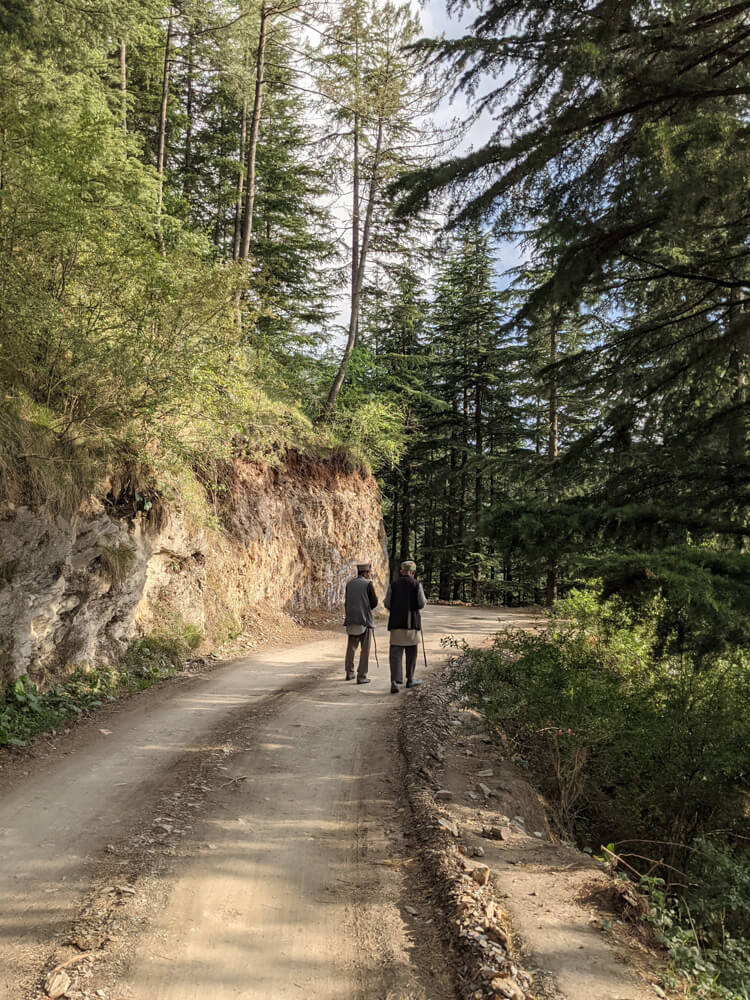
As this dhaba could only give us maggie we returned to Theog to first eat and pack some lunch. At a small old-time dhaba we ordered two potato parathas with butter and curd (which we ate with rajma). The dhaba owner told us the food was getting ready and he would be able to pack rajma (kidney beans) and chana (chickpeas) soon.
I’m sure I have praised Himachali dhabas before. But to say the least, these dhabas are the best food options in this state. We don’t find restaurants for a long time here. But dhabas are ubiquitous and for 60-70-80 rupees one can eat as much chapati, rice, rajma, curry, dry vegetable as one’s stomach allows.
Having packed four chapatis with rajma and chana (carry these tupperware to pack curried food) and gulping down two cups of tea each, we returned to the previous dhaba and parked our car.
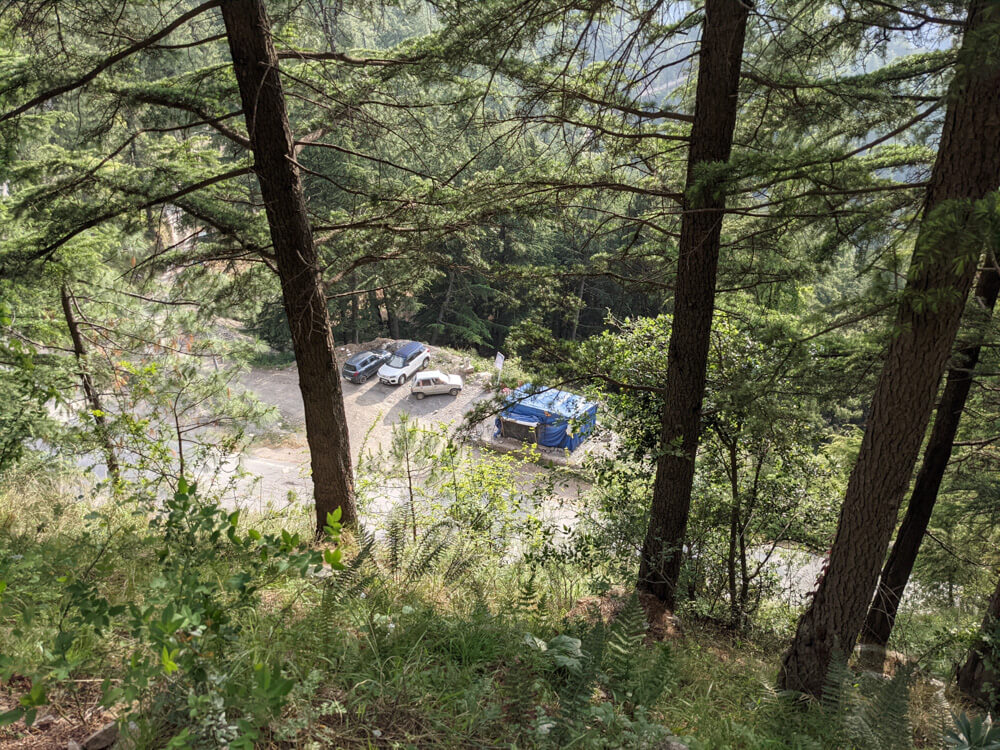
First, we had to walk on the road. Now you never have to walk the entire road length if you are in Himachal. Instead of walking the whole curve, you find a path that goes directly upwards to the upper part of the turn. All the roads and trails in the Himalayas will have these shortcut paths made by wayfarers.
Taking these shortcuts (the locals call them the same) we arrived at Sarion village. Several hills rose behind the village.
As we crossed a huddle of people, I saw charred potatoes lying outside the shop. The tin roof and walls of the shop had collapsed and parts of them were charred too. Villagers talked amongst themselves about lightning burning down the shop at night. How horrible the owner’s family must have felt to see their shop burned!
We asked the way to Kanag temple and started our climb. Amongst the two paths going upwards, we had to take the right one. The path was stony and went uphill. Loose rocks held the trail in many places and in parts it was muddy. As we trudged up, the valley below started becoming visible. Houses became smaller, and the wind got cooler. Voices of people were replaced with the chatter of birds. Terraced fields seemed symmetrical and arranged in a pattern from above, and deodar and pine trees stood imposing in clusters.
This wasn’t a trail that would be much damaged by rain. So in case, you plan to go in the monsoon, don’t worry about the path becoming all slippery and dangerous.
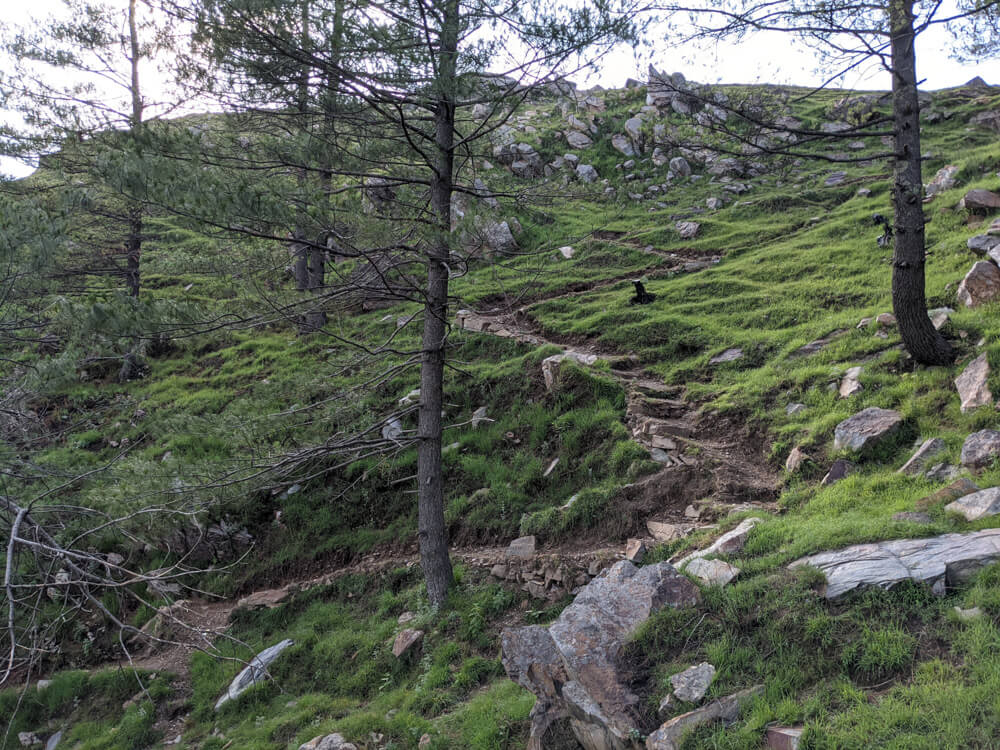
Many paths curve through the slopes of the hill on the left but one main wide trail goes straight upwards. When we confirmed the directions from a local man standing on the side of the road watching his cows, he told us not to take the random paths on the left. They aren’t good paths, they are risky, he said. Follow this main trail.
Most locals won’t suggest outsiders take the shortcuts or the random trails leading in their destination’s direction. Himachali people think people from outside would get lost or hurt in those unmaintained or less walked paths. If you are comfortable hiking on narrow paths that can get a bit tricky at points and trust your general sense of direction feel free to take these shortcuts. But if you are doubtful or scared stick to the known trail.
We do a mix of both. And that day, as advised, we didn’t take the dwindling rocky and steeper trails. Local’s advice can turn out to be precious in a new place, especially on a first-time journey. (But sometimes these overly precautious or underrated suggestions have cost us much. More on that later.)
A huge water tank stood on our left and the benevolent man told us he was filling it for devotees who walk to the temple. There is no other water source here, he said.
With a fair complexion and a reddish hue on his cheeks, the man seemed virtuous and determined to serve others. He pointed to a stone and mud house on the hill below and said it belongs to his wife’s family. Now her parents had passed away leaving their only daughter behind so they have to take care of this house and its farmlands also. And when everything is done here they go to Naldhera village where their cherry and apple orchards await them.
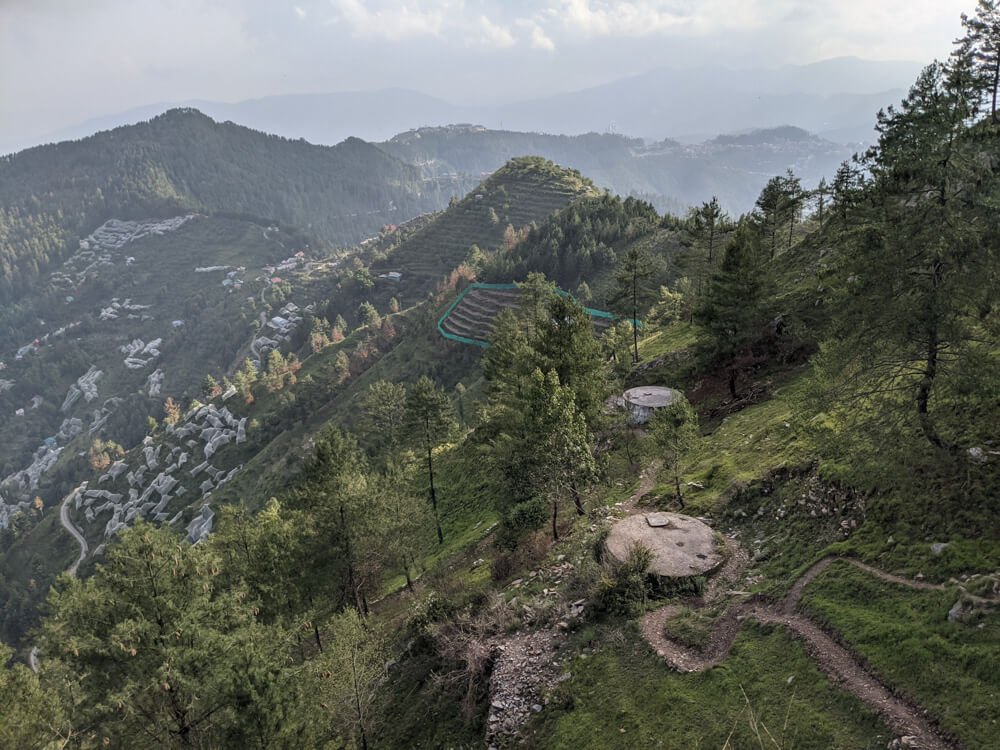
After talking for a while, we said our goodbyes and climbed up. The sun was climbing higher now and amidst the panoramic vista, only the heat bothered us.
The stony path curled around and about the mountains and took us to the summit within 40 minutes. At the top we found vast green pastures strewn with pine and cedar trees and wild bushes. The Kanag Devi temple stood in front. It was enclosed by a lot of red flags pegged into the ground in a circle to make sort of a fence around the temple. Further ahead, a closed hut with dustbins outside gave the impression of a dhaba but it was shut for the time.
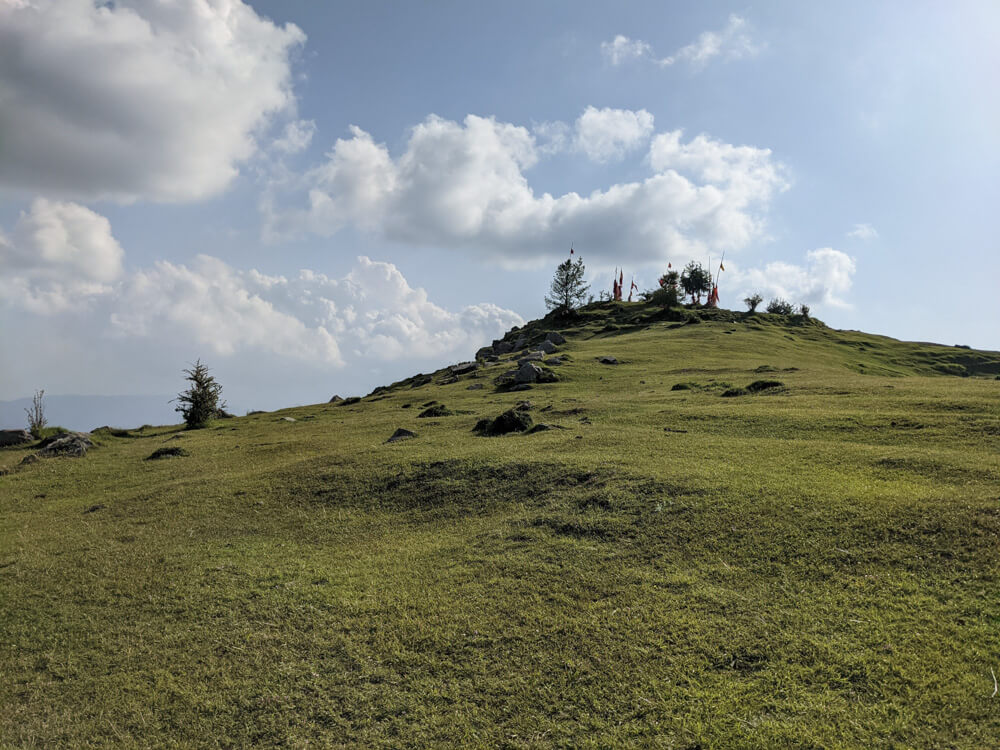
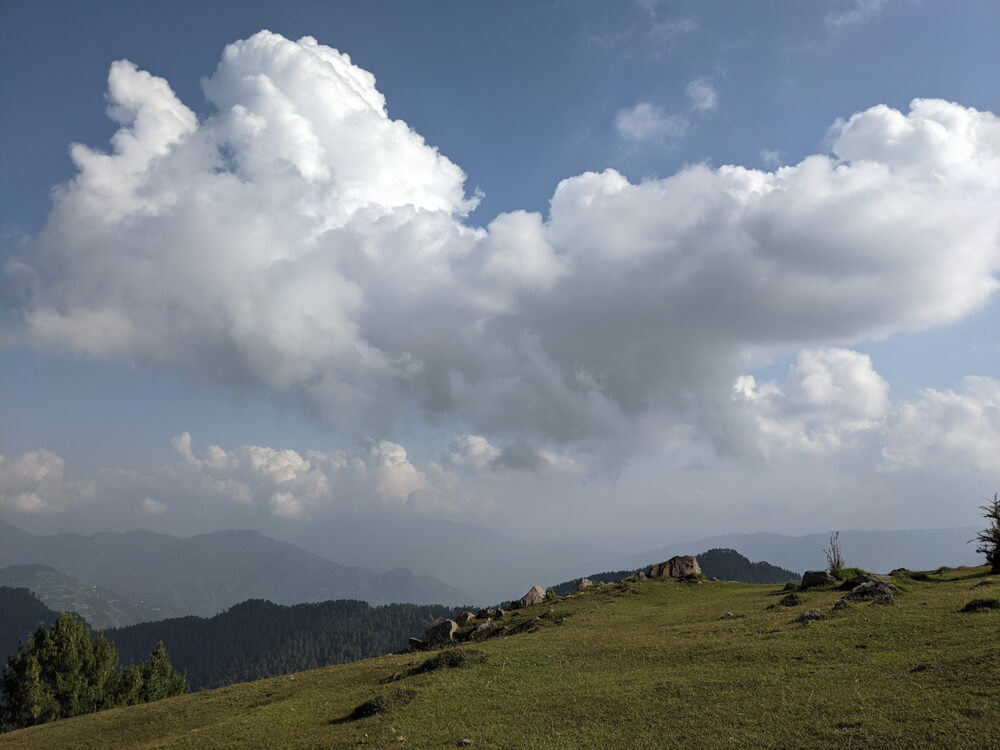
Soft cottony pastures filled the temple hill. The scenery from the top was open, and we could see in all directions. Homes seemed like anthills from that height. Making two rocks jutting out of the hill edge our seats, we admired the location.
Kanag Devi hill is a good place to do some roly-poly, as my partner and I like to call it. Fall and let yourself roll down the pasture. But there was so much cow and buffalo dung there that soon you would be a rolling stone gathering poop.
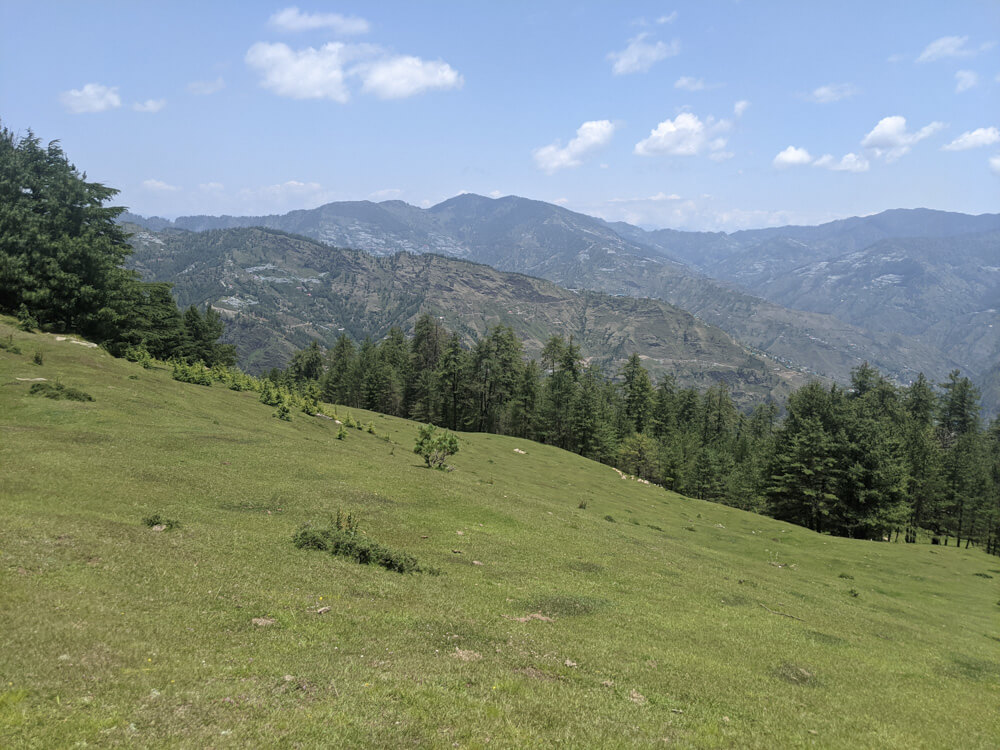
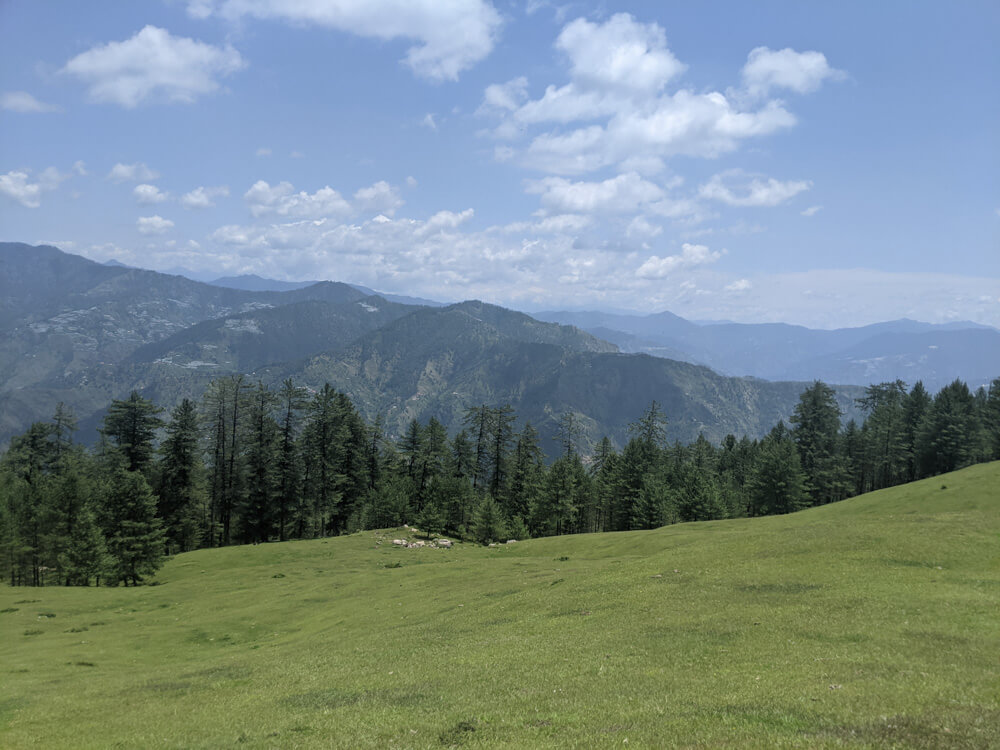
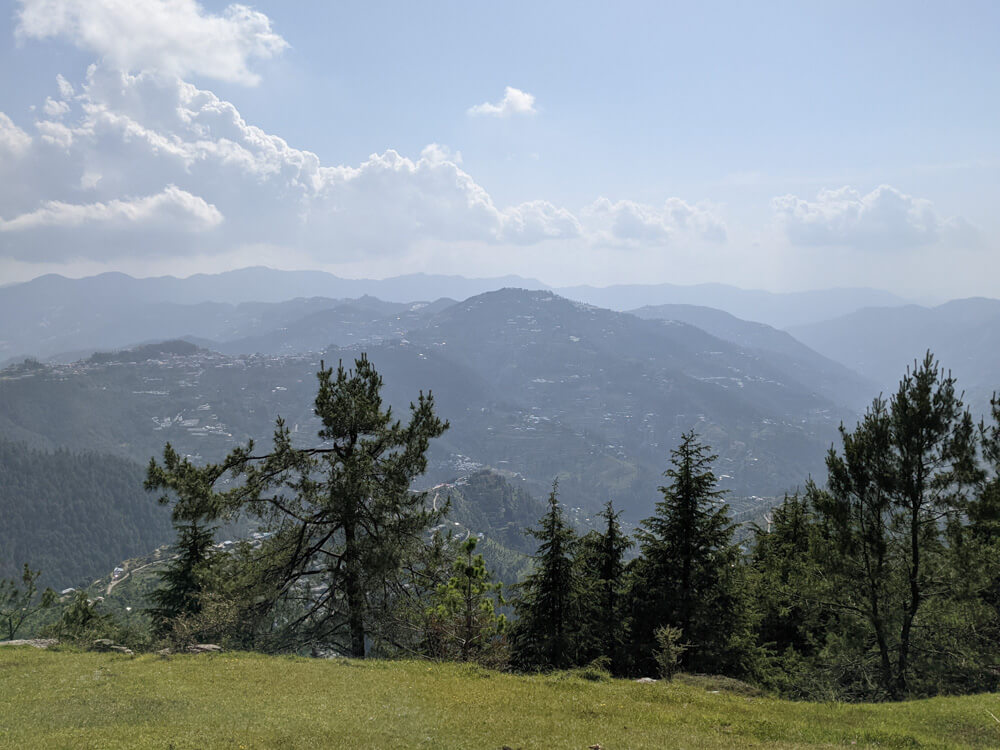
We ran down the hill and entered the deep jungle. Some villagers were cutting wood there. Many deodars and pines stood tall giving the much-needed shade. After resting under the trees for an hour and using the time to book our next homestay, we walked back upwards towards the pastures from where the views were more open.
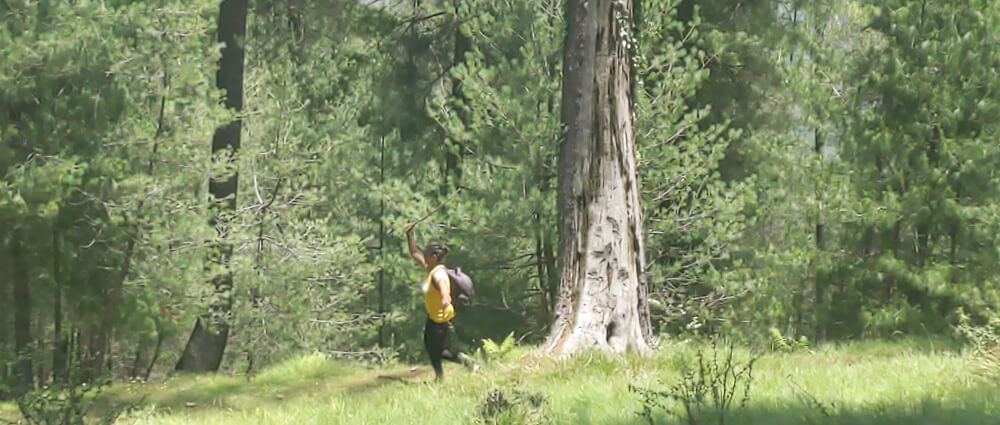
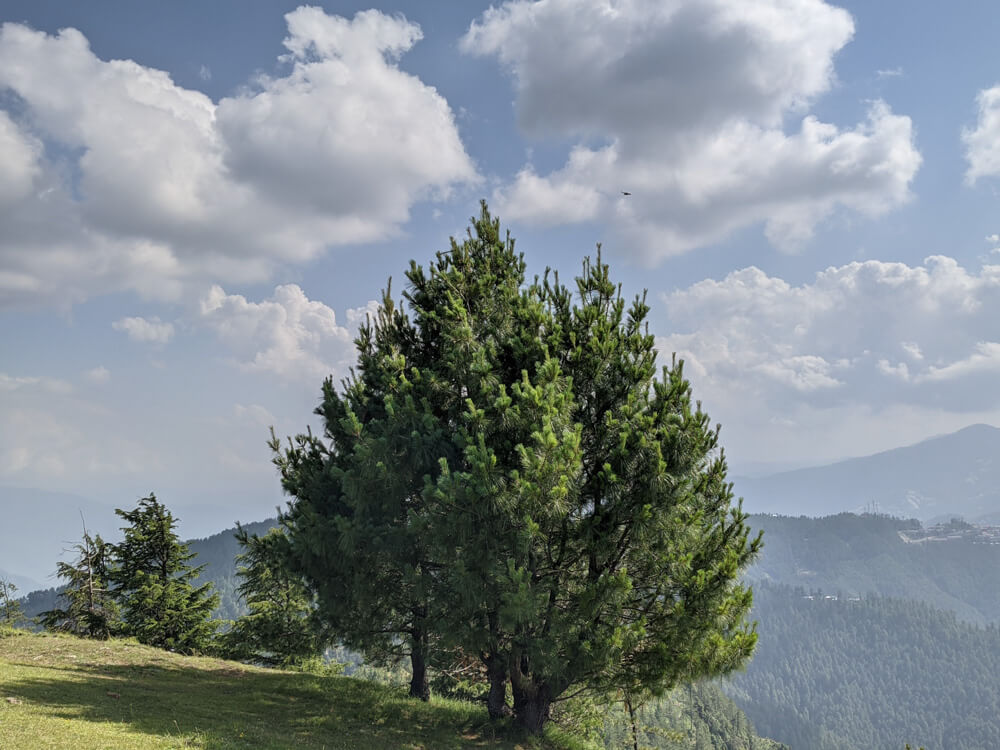
A collection of big rocks under stumpy pine trees was to be our home for the next couple of hours. These pines had such low branches that they looked like fat Santa. The grass was further softened with the golden brown pine needles shed by the trees. We could hide behind the boulders, pee in their shade, and felt a bit more secure resting against them.
Within seconds our bedcover was on the grass. First, we ate fists-full of cherries contesting against each other on who could keep the most cherries in the mouth at once. Then came the time to read and lie down in the sun and chat and just be.
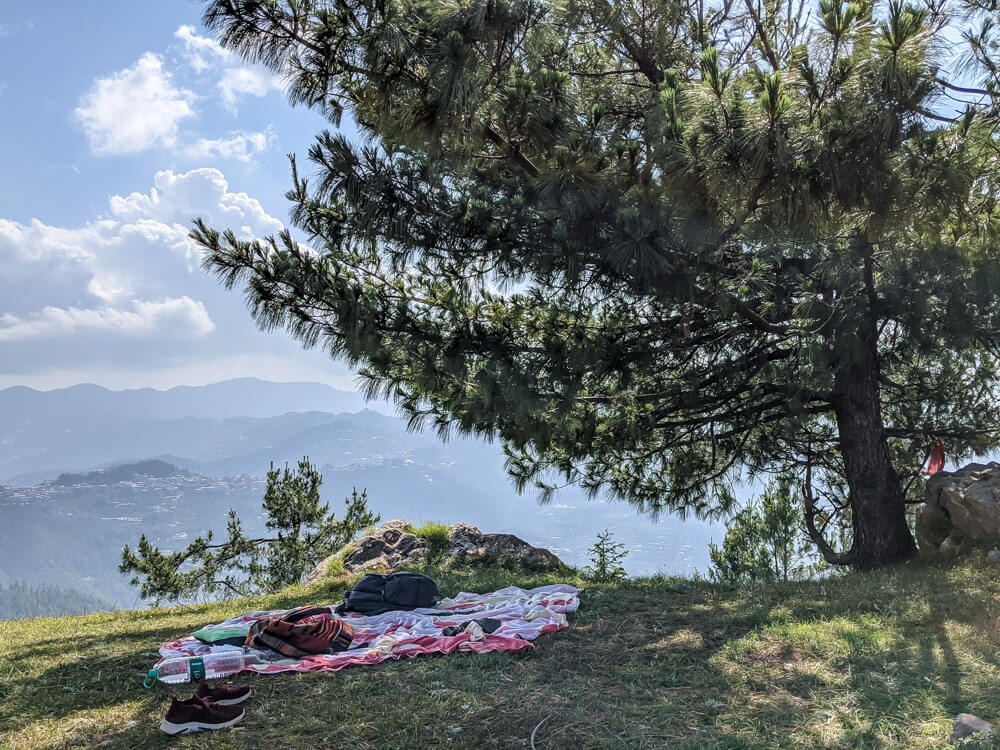
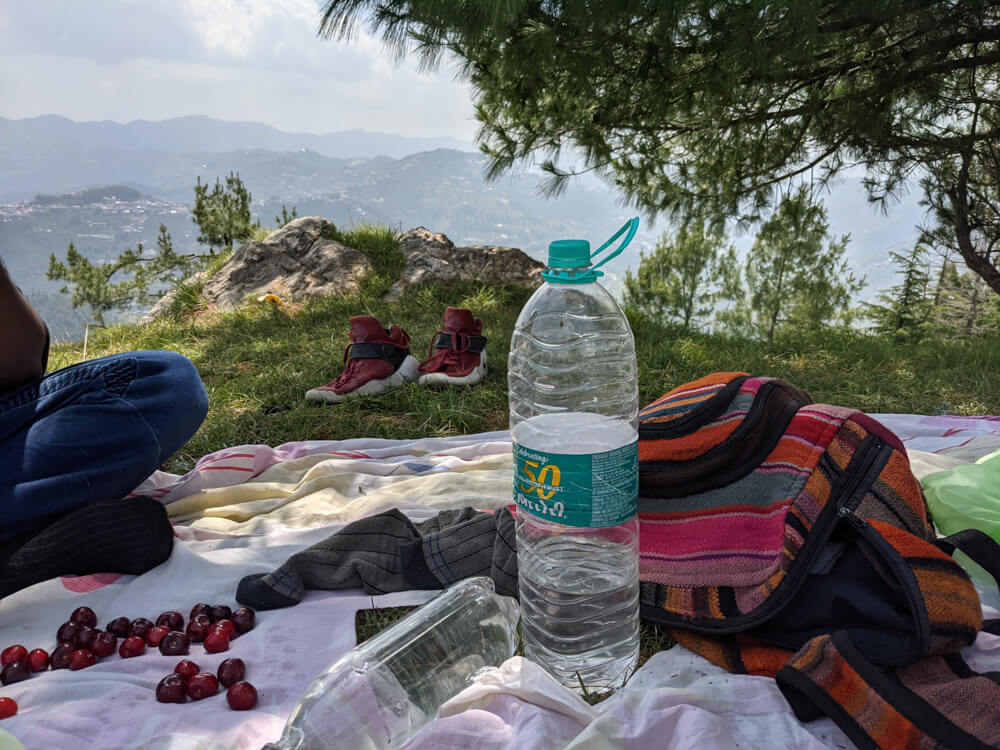
Lying down on a soft cotton bed cover while looking at the azure sky above did make me comfortable. But the views were still not as heavenly as described. Once you have climbed up to pastures like Bunbuni every other place will have to compete a bit harder.
Soon I saw big winged shapes floating above us in the sky. One would appear then it would quickly ascend up into the blue. I could see the outline of a bird. Then one came closer and I saw the golden pattern on the wings. It was a Himalayan Golden eagle. The valley was the perfect hunting spot for the giant eagles. These birds of prey have their territories defined, but in this valley, I saw many of them making their rounds for lunch.
I regretted not bringing my camera from the car. Half in shade and half in sun, I read Sherlock Holmes. Running a moment and then eating the salty rajma with chapati and then lying down again, those hours were blissful.
We can turn any place into heaven if we want.
But the peace lasted only so long because monkeys came to eat our banana peels and the chapatis we had thrown in the wild. They stuffed so much food into their mouth in one go and then ran and climbed up a pine branch and slowly ate the pieces. I was so amused to watch them. At a point, they came so close we had to scare them away by throwing stones in their vicinity. Else they would have come up to find our food from our bags.
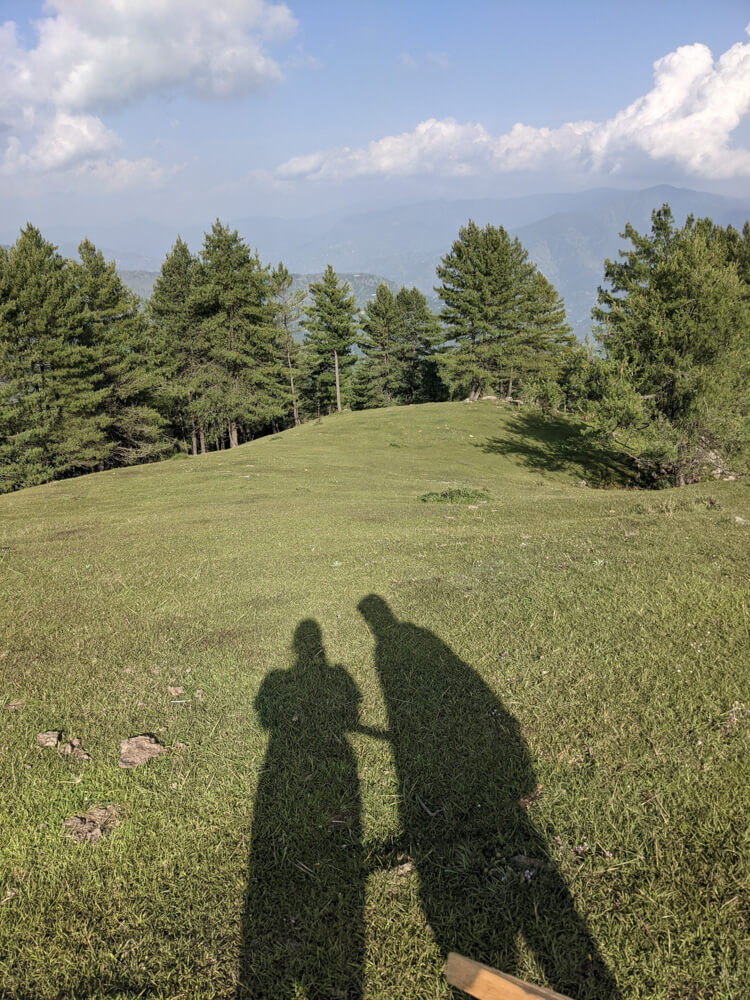
At about 4:30 we decided to leave. We came down the same way we had climbed up and only took one or two shortcuts. Of course, you can find your own path. I filled our water bottles from the tank and said our goodbyes to the man who was now busy reading a religious book. The descent to our car was full of fun and frolic.
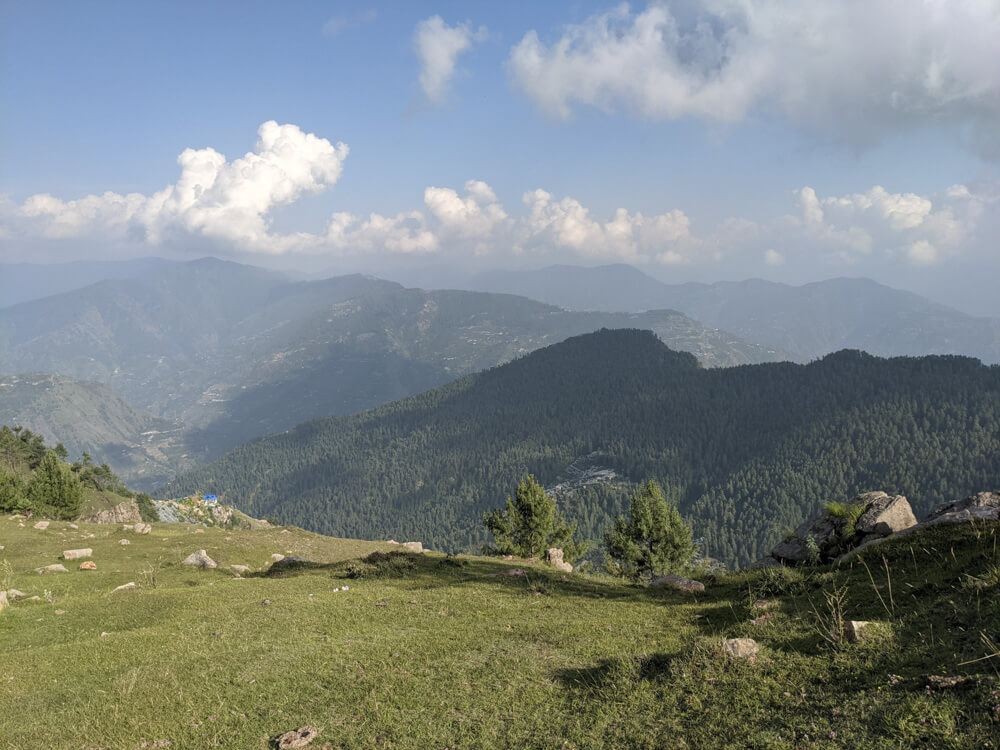
Instead of turning back towards home, we drove on towards a village where we had bought cherry on the road. A cherry farm owner there sold her cherries from a truck parked on the side of the road. As our one-kilo box which we had bought only a day earlier was getting over, now we wanted more. They were damn sweet and juicy. She was right there and we got one more kilo. 150 rupees for one box.
Giving in to tiredness, we declined her generous offer to visit her house for tea like the previous day and drove to Fagu. Stars filled the sky above our homestay and it didn’t take much energy to admire them. It was time to sleep deeply for we had had a great day and could only look forward to the night. What a fun-filled life.
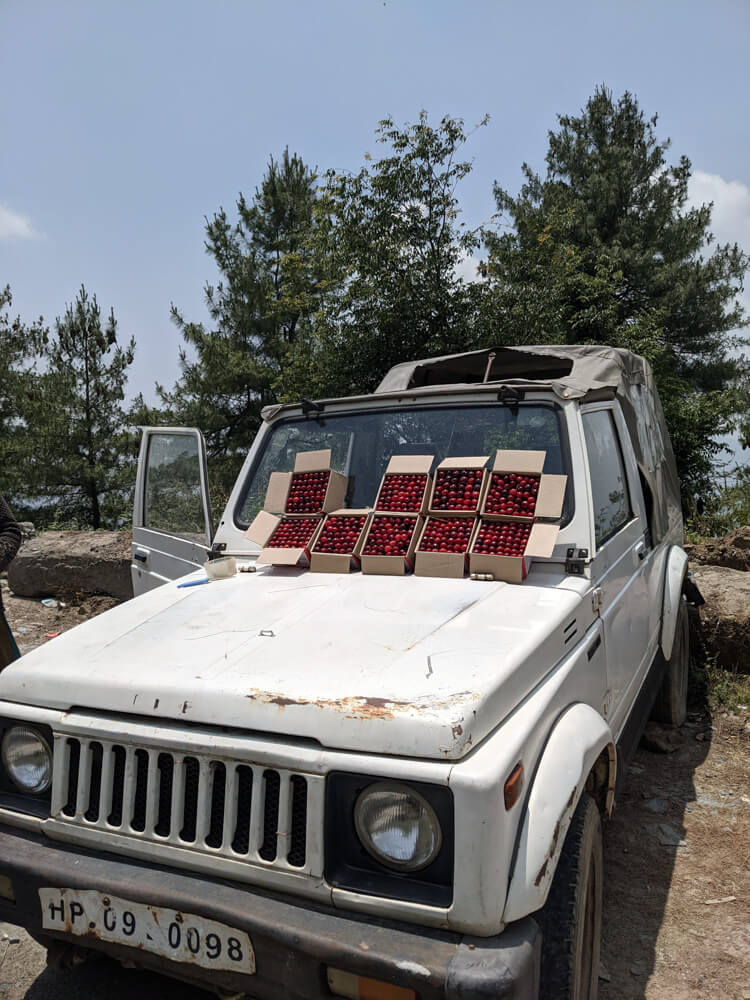
Kanag Devi is on Google Maps. Go here.
Where to stay in Fagu?
I was so disappointed by Fagu village and the surrounding area I won’t recommend you stay there. Instead browse through this list of places to stay in Shimla and choose a location and guesthouse of your liking.
Why don’t I like Fagu? Well to start with the average price per night for a simple room without cupboards or food starts from 1500 rupees or so going upwards to a few thousands. All homestays there are overpriced. The water seem to be a problem in the village, and the hosts often complain about the electricity and water costs. That is okay. But even at these tariffs they don’t want you to switch on lights when you may be justified to put it on.
Fagu isn’t friendly to long-term budget travelers but is more suited for 1 or 2 day visitors who want to spend a lot and rush around. The hosts themselves say they are running businesses. There is no tourism spirit there. Just the hurry of the hosts suggesting everyone to visit everything right now was a bit too much. We spent a week there though but wouldn’t go back.
If you really want to stay in Fagu, try Madhusudhan and Visihist homestay (Google search gives the right results). They are run by brothers and are sort of your best (worst?) bet. I stayed at Vishisht and don’t recommend it but luck runs out in Fagu.
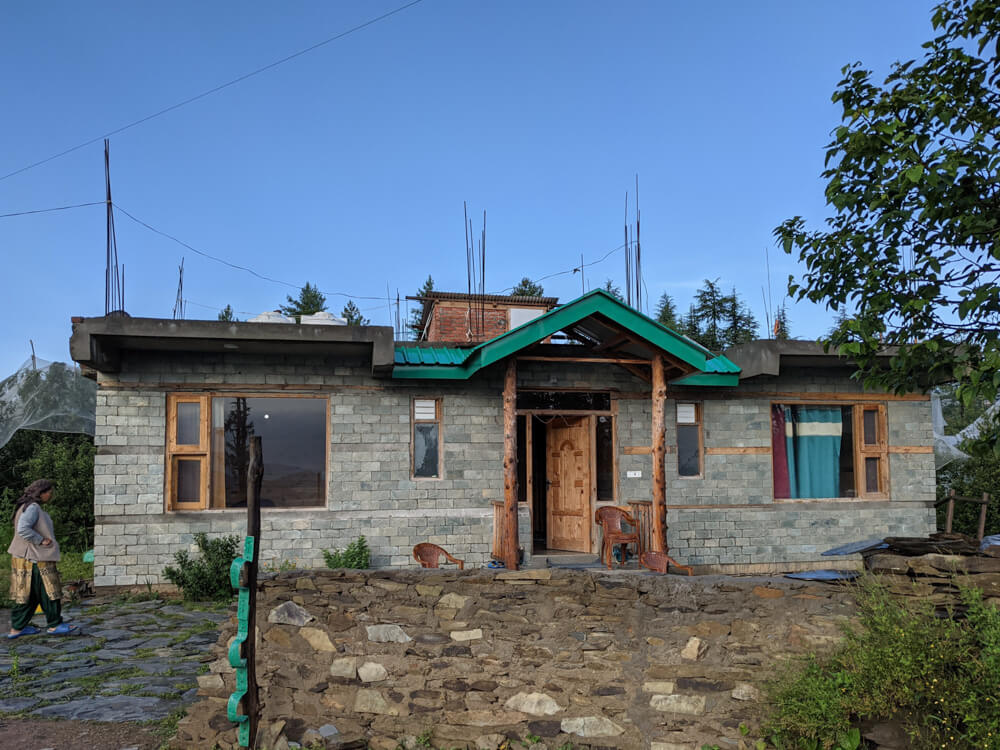
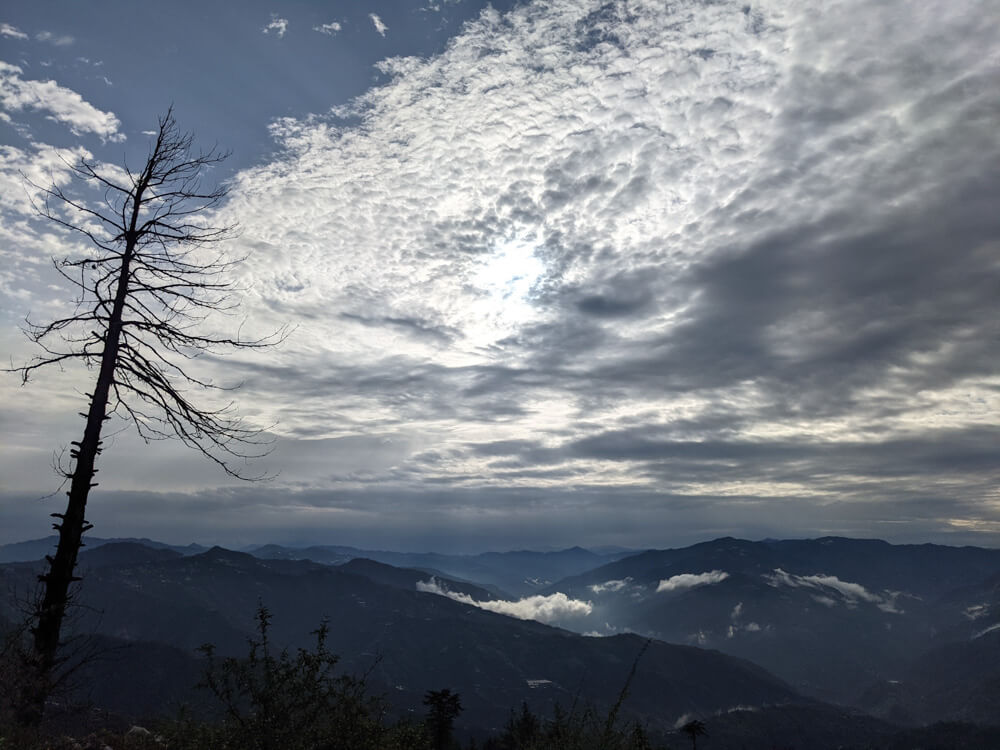
Did you enjoy this Kanag Devi memoir as much as I enjoyed the day? Let me know in the comments.
*****
*****
Want similar inspiration and ideas in your inbox? Subscribe to my free weekly newsletter "Looking Inwards"!

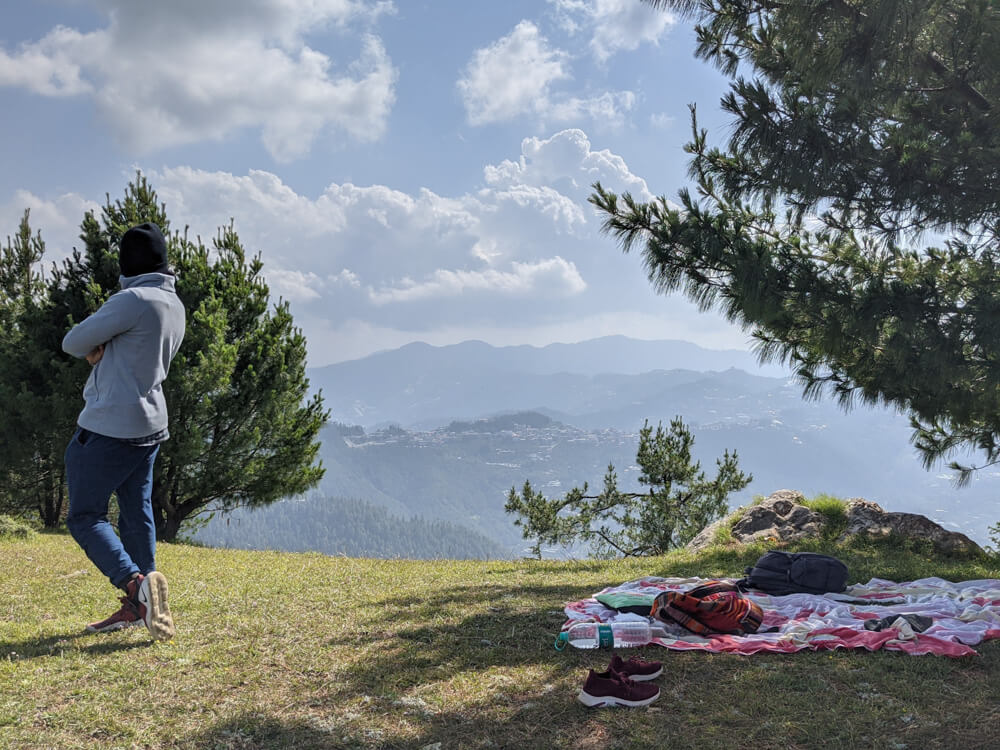
stumbled upon this blog while searching for Theog/Fagu/Kufri. I and my wife will be on a weeklong trekking trip in Himachal followed by spending a few days in Kinnaur and Sangla valley. On our way back to Chandigarh airport from Kalpa, we need to make a pit-stop for the evening and a few hours early in the morning. We were trying to find a place around (but not in) Shimla and have sort of shortlisted these three options. Basically, we would like to enjoy a good sunset, nice peaceful night and followed by a short sunrise hike somewhere before we head off to Chandigarh.You have any recommendations?